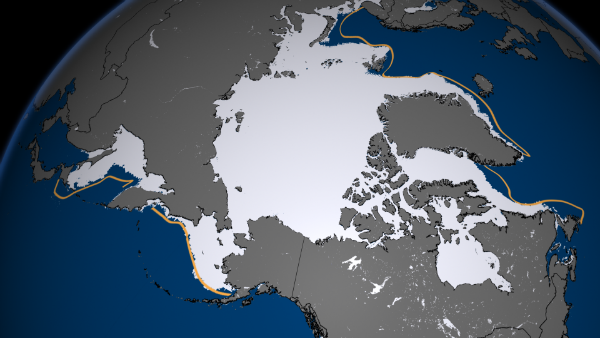Beginning of Arctic sea ice melting season

The average extent of sea ice in the Arctic has begun shrinking and will probably reach its minimum extent sometime in mid-September. Arctic sea ice reached this year’s maximum extent on March 15 at 15.13 million square kilometers (5.84 million square miles).
According to National Snow and Ice Data Center (NSDIC), the maximum extent was 733,000 square kilometers below the 1979 to 2000 average of 15.86 million square kilometers, and occurred five days later than the 1979 to 2000 average date of March 10, 2013.
 Arctic sea ice extent on March 15 was 15.13 million square kilometers (5.84 million square miles). The orange line shows the 1979 to 2000 median extent for that day. The black cross indicates the geographic North Pole (Credit: National Snow and Ice Data Center)
Arctic sea ice extent on March 15 was 15.13 million square kilometers (5.84 million square miles). The orange line shows the 1979 to 2000 median extent for that day. The black cross indicates the geographic North Pole (Credit: National Snow and Ice Data Center)
This year’s maximum extent was the sixth lowest in the satellite record. The lowest maximum extent occurred in 2011. The ten lowest maximums in the satellite record have occurred in the last ten years, 2004 to 2013.
 The graph above shows Arctic sea ice extent as of March 24, 2013, along with daily ice extent data for the previous five years. 2012 to 2013 is shown in blue, 2011 to 2012 in green, 2010 to 2011 in pink, 2009 to 2010 in navy, and 2008 to 2009 in purple. The 1979 to 2000 average is in dark gray. The gray area around this average line shows the two standard deviation range of the data. Sea Ice Index data.
The graph above shows Arctic sea ice extent as of March 24, 2013, along with daily ice extent data for the previous five years. 2012 to 2013 is shown in blue, 2011 to 2012 in green, 2010 to 2011 in pink, 2009 to 2010 in navy, and 2008 to 2009 in purple. The 1979 to 2000 average is in dark gray. The gray area around this average line shows the two standard deviation range of the data. Sea Ice Index data.(Credit: National Snow and Ice Data Center)
NSIDC will release a full analysis of the winter season in early April, once monthly data are available for March.
Arctic Sea Ice News & Analysis
Source: NSDIC
Featured image: The satellite-based measurement of the sea ice extent on March 15, 2013. The orange line indicates the median extent for the period 1979-2000. (Credit: NSIDC)

[…] of Arctic sea ice melting season Beginning of Arctic sea ice melting season The average extent of sea ice in the Arctic has begun shrinking and will probably reach its […]
Here are some interesting links to reports of the ice melting many years ago which if put into context shows that it is a natural cycle.
http://paperspast.natlib.govt.nz/cgi-bin/paperspast?a=d&d=ST18730328.2.20
http://news.google.com/newspapers?
id=PiohAAAAIBAJ&sjid=W34EAAAAIBAJ&pg=6753,466596&dq=arctic+ice+free&hl=en
http://trove.nla.gov.au/ndp/del/article/27078543?searchTerm=greenland%20ice%20melting&searchLimits
http://trove.nla.gov.au/ndp/del/article/9827111
http://trove.nla.gov.au/newspaper/result?q=greenland+ice+melting